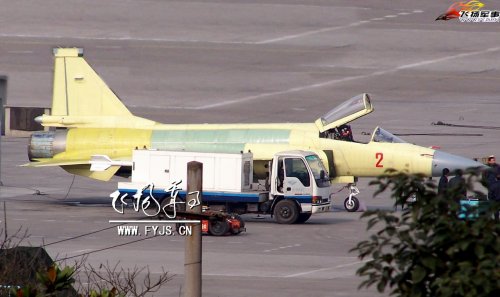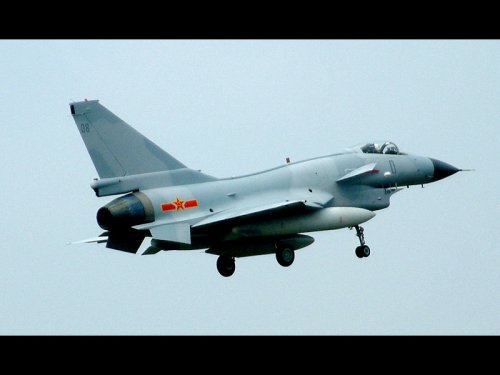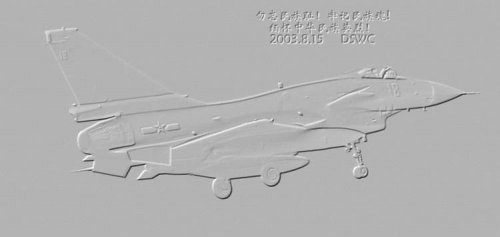- Joined
- 21 December 2006
- Messages
- 1,149
- Reaction score
- 741
To add to the two existing J-10 threads (on engine http://www.secretprojects.co.uk/forum/index.php/topic,1397.0.html and unveiling http://www.secretprojects.co.uk/forum/index.php/topic,506.0.html) below are my views on the project. Alternatives/discussions welcome - these views may simply betray my ignorance!
Wedge intake seems rather small. My guess is that it was intended to have a larger intake for a more powerful engine with a pitot intake (planned for later?). To reach some high speed design point (e.g. M 1.8-2.0) it required a wedge intake to be added to improve pressure recovery with the less powerful engine. This would reduce subsonic performance, but would make sense if high speed interception mattered. It would also explain the 'bodged' nature of the intake struts.
The canard seems to be the only destabilising surface, rather than the wing plus canards as on other aircraft, (e.g. Typhoon, which would be unstable even without its canards), which indicates a modest amount of instability rather than the most possible. Turn rates at all speeds are therefore not maximised, so it seems straight line flight is more important, where the canard will reduce trim drag, although in high AoA flight it will also improve the overall lift from the main wing, offsetting some of the high induced drag inherent in delta wings.
The flaps/elevons seem to compose of inner sections used for trimming purposes, probably to reduce the need for the canard to reduce lift through nose down trim - their small size/actuator making them little use for anything else, except perhaps high Mach roll control. The outer wing trailing edge surfaces seem to be 'flaperons', used for roll control and camber control, along with leading edge slats. The absence of slats on the inner wing shows the strong effect of the canards.
The nose has two main pitot and two AoA probes, which would indicate a triplex FBW system with dual redundant air-data - air-data is typically less redundant than the FBW. There also appears to be a single 'backup' of each probe type, perhaps for a backup analog FBW channel.
The very large fin (any fuel in there?), plus ventral strakes, would also indicate a desire for high Mach performance, when the CG shifts aft. The 'humped' fuselage seems to have that layout for area rule purposes, again indicating high Mach intentions. However, it also seems to allow a future 'saddle' fuel tank, which would make sense when a bigger engine comes along.
The main things that seems to reduce high Mach capability are the carriage of all weapons on pylons and all stores under the wing being pretty much in line, both adding a fair amount of wave drag (possibly offset by the fuselage area rule). This would reduce any supersonic cruise capabilty (as would the large wing root thickness/chord ratio) but would still permit high speed bursts with afterburner on.
The intake is as unstealthy a design as could be imagined, with no features that indicate this was given any consideration. The landing gear, fairly small wing/high lift devices and absence of thrust reverser indicate a lack of STOL/off base ability too.
Overall it seems to be essentially a defensive fighter with ground attack abilities. I would expect the J-11 to remain the main air superiority fighter, with the J-10 filling the role of the J-8.
Wedge intake seems rather small. My guess is that it was intended to have a larger intake for a more powerful engine with a pitot intake (planned for later?). To reach some high speed design point (e.g. M 1.8-2.0) it required a wedge intake to be added to improve pressure recovery with the less powerful engine. This would reduce subsonic performance, but would make sense if high speed interception mattered. It would also explain the 'bodged' nature of the intake struts.
The canard seems to be the only destabilising surface, rather than the wing plus canards as on other aircraft, (e.g. Typhoon, which would be unstable even without its canards), which indicates a modest amount of instability rather than the most possible. Turn rates at all speeds are therefore not maximised, so it seems straight line flight is more important, where the canard will reduce trim drag, although in high AoA flight it will also improve the overall lift from the main wing, offsetting some of the high induced drag inherent in delta wings.
The flaps/elevons seem to compose of inner sections used for trimming purposes, probably to reduce the need for the canard to reduce lift through nose down trim - their small size/actuator making them little use for anything else, except perhaps high Mach roll control. The outer wing trailing edge surfaces seem to be 'flaperons', used for roll control and camber control, along with leading edge slats. The absence of slats on the inner wing shows the strong effect of the canards.
The nose has two main pitot and two AoA probes, which would indicate a triplex FBW system with dual redundant air-data - air-data is typically less redundant than the FBW. There also appears to be a single 'backup' of each probe type, perhaps for a backup analog FBW channel.
The very large fin (any fuel in there?), plus ventral strakes, would also indicate a desire for high Mach performance, when the CG shifts aft. The 'humped' fuselage seems to have that layout for area rule purposes, again indicating high Mach intentions. However, it also seems to allow a future 'saddle' fuel tank, which would make sense when a bigger engine comes along.
The main things that seems to reduce high Mach capability are the carriage of all weapons on pylons and all stores under the wing being pretty much in line, both adding a fair amount of wave drag (possibly offset by the fuselage area rule). This would reduce any supersonic cruise capabilty (as would the large wing root thickness/chord ratio) but would still permit high speed bursts with afterburner on.
The intake is as unstealthy a design as could be imagined, with no features that indicate this was given any consideration. The landing gear, fairly small wing/high lift devices and absence of thrust reverser indicate a lack of STOL/off base ability too.
Overall it seems to be essentially a defensive fighter with ground attack abilities. I would expect the J-11 to remain the main air superiority fighter, with the J-10 filling the role of the J-8.





